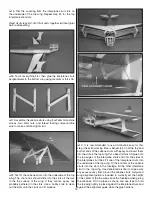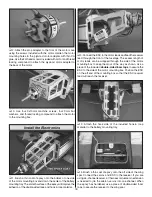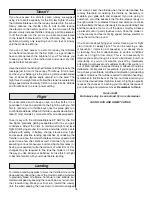
TORQUE ROLL
This is the same as the vertical hover but without the use of
right aileron to keep the model from rolling. If needed, you
can use a little left aileron to speed the roll up. As the model
rotates around, the controls will appear to be reversed to you
but only the orientation of the model has changed.
HARRIER
The harrier is nothing more than a high angle of attack fl ying
stall. Check the stall characteristics of your plane before
proceeding with this maneuver. Bring your plane across the
fi eld at 75 ft high and 100 ft out away from yourself. Slowly
pull back on the elevator while reducing throttle. The nose of
the plane should come up. Depending on the plane/setup,
you may have to make constant aileron (wing walking) and
rudder corrections for this maneuver. As the nose of the plane
comes up, start adding in a little bit of power to help maintain
airspeed. The rudder is now used to turn the model. This
maneuver will take some practice as there are a lot of small
corrections made to keep most planes in the maneuver.
This is one maneuver where less control is needed. Too
much elevator and the model goes into an uncontrollable
stall. The C.G. of the plane will have a large effect on the
stability of the model during this maneuver. Some planes
perform better with more elevator defl ection and a farther
forward C.G. while other planes prefer a further aft C.G. and
less elevator defl ection. Elevator to fl ap mixing can be used
on airplanes with marginal wing area, and some planes won’t
stall so elevator to spolieron mixing will be needed.
ROLLING HARRIER
Once you get comfortable with the up-right harrier, it’s time
to work rolls into the mix. From an up-right harrier, add in left
aileron and change from up elevator to down elevator when
inverted. If you are comfortable with four point rolls and slow
rolls, inputting rudder on the knife edges can improve the
maneuver considerably. To turn the model, simply input the
elevator or rudder a little sooner or later in the rotation. It’s all
a matter of timing.
PINWHEEL
Climb vertically and bring the model to a vertical hover, but do
not stop long enough to let the torque pull the model around
(climbing or sliding slightly will not be noticeable to spectators
but will keep air fl owing over the ailerons and provide you roll
authority to stop the torque). When the model is hanging,
rock the plane left with rudder, then apply full throttle and
full right rudder and hold both, completing 3/4 of a VERY
tight Knife Edge Loop and fl ying out Knife Edge. When done
correctly, the plane pivots around the wingtip in a very small
area. This maneuver can be done either direction.

































